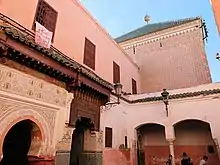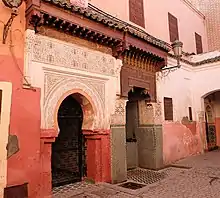Zawiya of Sidi Muhammad Ben Sliman al-Jazuli
The Zawiya of Sidi Muhammad Ben Sliman al-Jazuli (also Zaouia of Sidi Ben Slimane al-Jazouli or Zawiya al-Jazuliya, among other variations) is an Islamic religious complex (zawiya) in Marrakesh, Morocco. It is centered around the tomb of the 15th-century Muslim scholar and Sufi saint Muhammad al-Jazuli (also known as Imam al-Jazuli, full name: Abū 'Abdullah Muḥammad ibn Sulaymān ibn Abū Bakr al-Jazūli al-Simlālī), who is one of the Seven Saints of Marrakesh.
| Zawiya of Sidi Muhammad Ben Sliman al-Jazuli | |
|---|---|
الزاوية الجزولية | |
 The northern side of the zawiya. The structure with the green pyramidal roof is the mausoleum chamber. | |
| Religion | |
| Affiliation | Islam |
| Location | |
| Location | Marrakesh, Morocco |
| Geographic coordinates | 31°38′11.1″N 7°59′30.7″W |
| Architecture | |
| Type | zawiya |
| Style | Saadian, Moroccan, Islamic |
| Founder | Ahmad al-'Araj |
| Date established | 1523-24 CE |
Historical background
Al-Jazuli was a major figure in the history of Moroccan Sufism. He lived at a time when local Sufi movements were also filling a void of political leadership against the encroachment of Portuguese and Spanish forces into the country.[1] Originating from the Sous region in southern Morocco, he spent much time in Fes where he wrote his most famous work, the Dala'il al-Khayrat,[2] and gained enormous influence over zawiyas and followers across the country.[1]:335–36 He subsequently moved around the coast of Morocco until he died near Essaouira in 1465 and was buried in the village of Afoughal.[1]:336[3]
Later on, the early Saadians, who were also from the Sous region, associated themselves with al-Jazuli's followers as they established their own political power in southern Morocco. Thus, when Ahmad al-'Araj (the effective founder of the Saadian dynasty) moved to Marrakesh in 1521 he quickly arranged for the transfer of al-Jazuli's body here in 1523-24 along with that of his own father (who had been buried near al-Jazuli in 1517).[1][4] The Saadians built a religious complex and mosque around the new mausoleum.[5]:123
After the reign of Muhammad al-Sheikh (Ahmad's brother, who had managed to dethrone him), the dynasty distanced itself from al-Jazuli's disciples.[1] Nonetheless, al-Jazuli came to be considered one of the Seven Saints of Marrakesh and his tomb was a prominent stop for pilgrims to the city.[5][3][6] While the mosque of the complex may still date from the Saadian period, the rest of the zawiya was frequently modified and restored over the years, particularly in the 18th century.[4] The Alaouite sultan Moulay Isma'il was responsible for building the current mausoleum chamber with its large pyramidal cupola as well as for expanding the attached mosque and converting it to a Friday mosque.[1]:474 The zawiya was significantly restored or modified under Moulay Muhammad ibn Abdallah (who was made governor of Marrakesh in 1746 and ruled as sultan from 1757-1790) and was repaired in 1867-68 under Moulay Muhammad ibn Abd al-Rahman.[1]:509, 533
Architecture and layout
The mosque and mausoleum complex
The zawiya is a complex of structures and facilities which provide for a number of services and functions. Their architecture is similar to that of other Saadian religious complexes in the late 16th century such as the Mouassine Mosque and Bab Doukkala Mosque, as well as the later Zawiya of Sidi Bel Abbes. The center of the complex is occupied by a mosque with a rectangular floor plan consisting of a nearly square courtyard (sahn) and an interior prayer hall divided into five naves by rows of arches.[7] The interior of the mosque is not heavily decorated.[4] North of the sahn is another courtyard which leads to the mausoleum chamber of al-Jazuli: a large square chamber higher than the surrounding structures and covered by a wood-frame cupola and, from the exterior, a pyramidal roof with green tiles, visible from the street and typical of Moroccan royal and religious structures.[7] Immediately on the east side of the mausoleum are two of the zawiya's main entrances, alongside a decorated street fountain. Behind these is a small chamber which served as a madrasa or school. The rest of the complex, on its eastern side, is occupied by the house of the muqaddam, a hospice for pilgrims, and a large midha (ablutions house) with a central water basin and 14 latrines.[7]
The cemetery and the Saadian mausoleum
The establishment of the zawiya also led to the development of a small cemetery along its western flank (separate from al-Jazuli's actual mausoleum chamber) which also served as the very first burial site of the Saadian dynasty in Marrakesh (before the later Saadian Tombs in the Kasbah). Soon after Muhammad al-Sheikh was assassinated by the Ottomans in 1557, Ahmad al-'Araj (his brother) was put to death, along with all his possible male heirs, allowing Moulay Abdallah al-Ghalib to accede to power unchallenged.[4] After a time, Ahmad and his sons were buried near al-Jazuli's mausoleum on the initiative of the local scholar Abu 'Amru al-Qastali al-Murrakshi.[4] According to his tombstone's inscription, his daughter 'Aysha was responsible for erecting the domed mausoleum, known as the Qubba al-Ashraf, over his tomb. His tombstone, carved in black marble, disappeared sometime after 1946. Another tombstone within the mausoleum is believed to be for Ahmad's father, Muhammad Ibn 'Abd al-Rahman (also known as al-Qa'im bi-'Amrillah), though this is not confirmed by any inscription.[4] The mausoleum structure is a simple chamber made in brick with a dome on an octagonal base. Inside, the upper walls of the chamber are decorated with arabesque and epigraphic motifs carved in plaster.[4]
See also
References
- Deverdun, Gaston (1959). Marrakech: Des origines à 1912. Rabat: Éditions Techniques Nord-Africaines.
- Jazūlī, Muḥammad ibn Sulaymān; Efendi, Kayishzade Hafiz Osman Nuri (1877). "The Waymarks to Benefits". World Digital Library (in Arabic). Baʻlabakk, Al-Biqāʻ, Lebanon. Retrieved 17 May 2020.
- Allilou, Aziz (2014-12-14). "Who Are the Seven Immortalized "Saints" of Marrakesh?". Morocco World News. Retrieved 2020-05-17.
- Salmon, Xavier (2016). Marrakech: Splendeurs saadiennes: 1550-1650. Paris: LienArt. ISBN 9782359061826.
- Wilbaux, Quentin (2001). La médina de Marrakech: Formation des espaces urbains d'une ancienne capitale du Maroc. Paris: L'Harmattan. ISBN 2747523888.
- read, Mohammed Khan Spiritual Travel 14 min (2015-05-16). "Untold Marrakesh: The Seven Saints". Sacred Footsteps. Retrieved 2020-05-17.
- Marçais, Georges (1954). L'architecture musulmane d'Occident. Paris: Arts et métiers graphiques.


